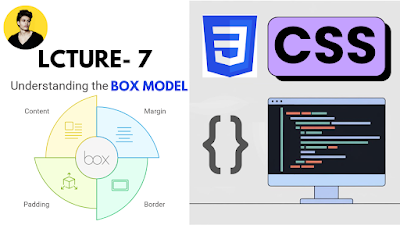CSS Box Model Explained: Margin, Border, Padding & Content – by SR Programist
 |
| CSS Box Model Explained – by SR Programist |
Introduction
When designing a website with CSS, understanding the Box Model is essential. It defines how elements are displayed, sized, and spaced on a webpage. Without a proper grasp of the Box Model, achieving precise layouts can be challenging.
In this blog post, we’ll explain the CSS Box Model in simple terms, covering its four key components: Margin, Border, Padding, and Content. Plus, watch our detailed video "CSS BOX MODEL EXPLAINED: MARGIN, BORDER, PADDING & CONTENT | L-7 | SR PROGRAMIST" for a step-by-step demonstration!
What Is the CSS Box Model?
The CSS Box Model is a fundamental concept that determines how elements are displayed in a structured layout. Every HTML element is treated as a box consisting of four main areas:
- Content – The actual text, image, or element inside the box.
- Padding – The space between the content and the border.
- Border – The edge surrounding the padding and content.
- Margin – The space outside the border that separates elements.
Understanding these areas helps in designing well-structured and visually appealing web pages.
Why Is the CSS Box Model Important?
Using the CSS Box Model correctly ensures:
- Better Control Over Layouts – Adjusting margins, padding, and borders helps in designing responsive and visually balanced pages.
- Consistency Across Elements – Applying a structured box model ensures uniform spacing and alignment.
- Improved Readability – Proper spacing between text and other elements enhances user experience.
- Optimized Responsive Design – Controlling box dimensions helps create layouts that adapt to different screen sizes.
Components of the CSS Box Model
1. Content
The content is the innermost part of the box, where text, images, or other elements are placed. It defines the actual width and height of the element before adding padding, border, and margin.
2. Padding
Padding is the space between the content and the border. Increasing the padding creates more spacing inside the box, making elements look less crowded.
3. Border
The border surrounds the content and padding. It can have different thicknesses, styles, and colors, making elements more distinct.
4. Margin
Margin is the space outside the border. It helps in separating elements by increasing the distance between them.
Best Practices for Using the CSS Box Model
- Use consistent margins and padding to maintain a uniform design.
- Avoid excessive padding, which can cause layout issues.
- Use border-box sizing to include padding and border inside the total width and height of an element.
- Maintain adequate spacing to enhance readability and user experience.
- Optimize responsive design by adjusting box model values for different screen sizes.
Watch the Full Tutorial on YouTube
To see the CSS Box Model in action, watch our video "CSS BOX MODEL EXPLAINED: MARGIN, BORDER, PADDING & CONTENT | L-7 | SR PROGRAMIST."
Join the Community
Stay updated with the latest tutorials and projects by subscribing to my YouTube channel, SR Programist, and following me on Pinterest and Instagram for bite-sized content and updates!. Let’s build amazing websites together!
👉 Don’t forget to like, share, and subscribe to my channel for more web development tutorials! and stay tuned for my Front-End Web Development Full Course 2025!
Conclusion
The CSS Box Model is the foundation of web design. Mastering Margin, Border, Padding, and Content will help you create professional, well-structured layouts.
For more in-depth tutorials, subscribe to SR Programist and stay updated with the latest web development techniques!
Happy Codding

Post a Comment